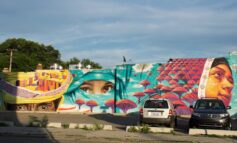HAMTRAMCK — To Chilean Muralist Dasic Fernández, graffiti is a means of self-expression, with universal appeal. It does not have a specific audience, nor does it aim to transmit defined ideas.
The renowned artist is in Hamtramck to paint a Yemeni-themed mural that will celebrate the community’s heritage and presence in the city.
The mural will cover the 80 x 16 ft wall of Sheeba, a traditional Yemeni restaurant, at 8752 Joseph Campau St., in south Hamtramck.
Fernández started the work by sketching a few lines on the wall on Saturday, Nov. 9.
The mural will cost $20,000, but the organizers have only gathered half of the amount needed.
The project was started by OneHamtramck and sponsored by The Arab American and Chaldean Council (ACC).
The mural will feature a group of Socotra Dragon Trees, which are abundant in Yemen; Arab-inspired geometric shapes; and three characters: A woman with a headscarf, a man masked by a veil that displays a sky and another man in a traditional Yemeni turban.
Fernández told The Arab American News in an interview that he is looking to preserve the universal nature of his work in the mural, while reflecting Arab and Yemeni culture in the city.
“I want to put my own stuff and make it more colorful and contemporary,” he said.
Fernández added that he often uses masked faces in his murals, so the characters would not identifiable, which makes the work more inclusive.

|
| Fernandez. |
The muralist demands the full trust of those who hire him for mural projects. He says he needs freedom because he’s an artist, not a graphic designer.
“Graphic design is a channel. You choose the message and the receptor,” he explained. “But in art, everybody is the receptor. You’re not trying to sell a product or show a message to specific people. In art, the first person who has to like the work is the artist himself.”
He adds that art is spontaneous in nature and based on instinct, not planning.
“Sometimes, I hurry with painting some ideas before I stop liking them,” he said.
Fernández, 27, was born in the town of Rancagua. In his early teens, he was influenced and fascinated by the Chilean hip hop culture. He wrote song lyrics and still writes today as a hobby. But he found graffiti the best way to be a part of that musical culture.
He started his art career by “tagging” buildings in his hometown with his name in elaborate fonts.
At age 18, Fernández started attending the University of Chile in the capital Santiago, where he studied architecture.
He says in school he was introduced to the concept of a “public space,” which was fundamental to his pursuing painting on walls as a career.
“I wanted to turn spaces into places with a soul and a character,” he said.
The muralist stopped focusing on tagging letters and went into painting colorful murals. Today his paint could be seen on walls throughout the Western Hemisphere. He painted murals in Buenos Aires, Rio de Janeiro, Montevideo, Detroit and New York, where he is now based.
He said the graphic culture varies from one place to another. For example, in the U.S., where there is little space to paint, graffiti is conditioned by the police, so police brutality is a common theme. In Chile, he says, it is easier to paint graffiti, but the paintings is mostly political, due to the country’s political turmoil in the 1970’s and 80’s.
Fernandez said powerful graffiti is a product of the economic and political situation in cities like Detroit.
“Everywhere people are marginalized, there will be graffiti. It is the need of saying ‘I am here. I’m not different,'” he said. “Graffiti is not here to give hope. It is a tool to remind people of others’ existence — that we are human beings.”
He added that Detroit is an “exciting” place for muralists and graffiti artists because of the abundance of available walls.
“Detroit is one of the main cities for art in America,” he said.
The artist said painting on public and private property, which is viewed as vandalism, could be a powerful form of art and self-expression.
“Art makes you question. When young people tag somebody’s property, that makes you wonder why they need to do that, and think about the anger,” he explained. “Sometimes it’s about pushing the limits.”
“A city with totally clean walls would be fake, would be a lie,” he said.





Leave a Reply